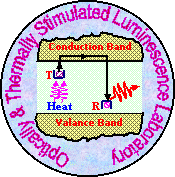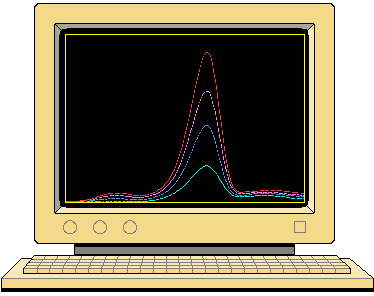 |
|
 |
Characteristics of TLDsThe TLDs have advantages which are listed below:
2. High sensitivity, that is high light output for a given exposure, means the dosimeter can be made small and convenient to wear. 3. They can be used to measure dose over a long period (months or even a year) with very little fading. 4. The light output is a linear function of the absorbed dose which makes calibration easy. 5. LiF is a reasonably good tissue equivalent for beta and gamma radiation. (This is not true for neutrons. LiF output is very dependent on neutron energy). 6. Can distinguish between types of radiation by using different lithium isotopes as will be discussed below.
2. Since it is not possible to tell whether or not the TLD has absorbed a dose, all TLDs must be read and annealed each monitoring period. 3. Dust on the detector will glow when heated and will be recorded by the phototube as a false reading. 4. The TLDs are sensitive to exposure by ultraviolet light and therefore must be sealed in a light-tight badge. Accuracy of Dose Assessment with TLDsThe TLD gives a measurement of dose absorbed in the TLD (in mGy) with an accuracy of aboutThere are many uncertainties involved in this assessment. Also, dosimeters worn on the surface of the body can at best be regarded as a statistical sampling device which provides a record of the dose received by one part of your body surface during your movements around the site. When these factors are allowed for, we can expect an accuracy of about Comparison of TLD and DRD ResultsThe BRMD TLD badge is the only dosimeter recognized by the regulatory authorities and is the dosimeter of record at TRIUMF. DRDs are often used when immediate dose information is required for dose control purposes. DRD results, are not an official record unless used as an estimate when a TLD result is not available.Difference in doses measured by a TLD and a DRD are to be expected for the following reasons:
2. A large number of dosimeters, of either type, placed in the same radiation field will show a variation of up to 3. DRDs may read high in fields where high energy beta particles exist. 4. DRDs suffer from leakage and mechanical shock which can alter readings. 5. Small rounding off errors made in each reading are cumulative and can distort the value of cumulative doses derived from DRD readings. Extremity TLDsExtremity TLDs are small discs of LiF which are sealed in plastic holders. These are worn on the fingers or taped to the ankles to measure the external equivalent dose to the extremities i.e. hands, forearms, feet and ankles. They are made of LiF powder spread very thinly into a plastic wafer so that they may be worn comfortably.Extremity TLDs are designed to measure beta radiation at a depth equivalent
to that of the sensitive basal layer of the skin (about 0.3 mm). The holder,
either a ring or a finger stall, shields the TLD from the lower energy
betas (70 keV and less) which can not penetrate to the basal layer. Gamma
radiation is also recorded by extremity TLDs, and delivers a dose to the
bones of the extremities in addition to the skin dose. The danger from
a high skin dose, When to Wear Extremity TLDs
2. when working with the whole body shielded except for the hands; 3. when handling small non-shielded gamma sources; 4. for decontamination jobs when beta contamination is present; 5. for glove box operations; 6. for 7. in any radiation field which would give the extremities Neutron DosimeterIn addition the badge contains a piece of polycarbonate (a plastic called CR-39 also used in the manufacture of eye glass lenses. Fast neutrons which interact with the plastic leave an invisible damage track in the plastic which can be made visible by enlarging the tracks using an etching technique. By counting the number of etch tracks per unit area in the plastic, a measure of the fast neutron dose can be obtained. These badges are only worn by people who are likely to be exposed to neutron fluxes above the very low levels normally found outside the accelerator shielding. Summary
TLDs measure absorbed dose. They are the official dosimeter for dose record purposes for external gamma and beta radiation. |